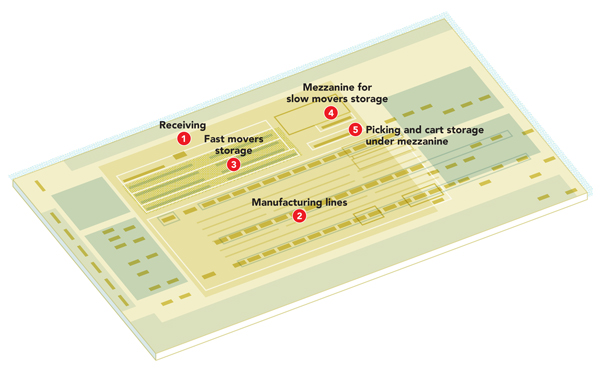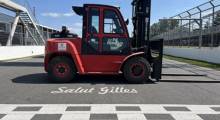The Braun Corp., Winamac, Ind.
Facility size: 200,000 square feet
Products: Manufacture wheelchair-accessible minivans
Throughput: 25 vehicles/day
Shifts: one shift, five days a week
Employees: 250
Thanks to improved storage and the use of tuggers and carts, Braun Corporation was able to redeploy warehouse associates, reduce needed storage space, slash inventory and improve safety.
Receiving: Upon arrival, inbound shipments are assigned to one of three dock doors in the receiving area (1). Roughly 90% of incoming shipments are less-than-truckload (LTL). In the receiving area, associates pull the packing lists, unload the truck and manually key incoming parts into the system. Just-in-time deliveries are briefly staged before being delivered directly to the manufacturing line (2).
Storage: The system does not direct putaway from receiving, but there are specific storage locations for specific types of product. Fast movers are directed to rack and carton flow storage (3) closer to the assembly line. Slow movers are directed to reserve storage (4) on the mezzanine. During putaway, items and locations are scanned and become available in the system for use on the line.
Picking: Picking is achieved in a number of ways. Some pick lists are generated from a spreadsheet based on demand. This is generally for low-volume, high-mix components. Some picking involves standard bin sizes filled with product in multiples of the current run rate.
For example, if the line is running at 16 units per day, and a part is one per unit, then an associate will pull 16 to a bin at a time. Pickers push a single cart at a time and pick primarily to a cart filled with bins. The cart travels with operator through the warehouse until full, when it is manually deposited in sequence at the cart staging area (5). When directed by the system, a tugger operator will connect to a train of three full carts.
The operator will drops off an entire cart at the right station at the line. Assemblers either work from the cart or remove bins and work from them.
Empty bins are returned to the cart, and when the entire cart is empty the tugger operator will remove three at a time from the line to return them to the staging area.
The tugger will only ever pick up an entirely full or entirely empty cart.
System suppliers
System integrator: Braun Corporation
Tugger: Columbia Par-Car
Carts: Creform; Topper Industrial; in-house
Pallet Rack: Ridg-u-Rak
Lift trucks: The Raymond Corp.
Mobile computers: Glacier Computer
Handheld scanners: Intermec









